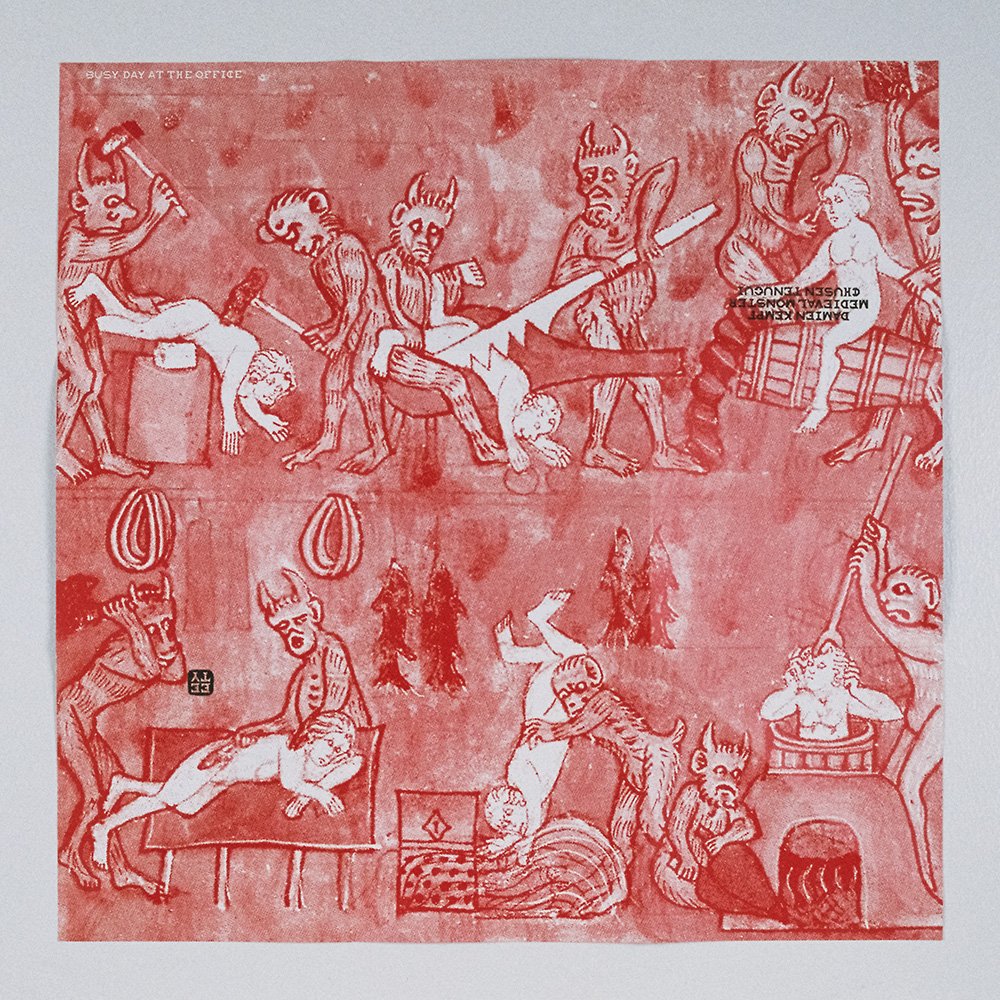DAMIEN KEMPF
medieval monster chusen tenugui
Damien Kempf is a specialist of medieval art and culture (Twitter: @DamienKempf , Instagram: @damien_kempf). He is also a "monster hunter", who looks for strange creatures in medieval illuminated manuscripts. He is known as the man who discovered Yoda, a fictional character in the Star Wars movies, in a 14th-century manuscript. Kempf has introduced to the general public various monsters through social media and his books, Medieval Monsters (co-authored with Maria L. Gilbert) and Medieval Monster Hunter. Because of Kempf's witty captions and the fascinating design of monsters, illustrations from century-old manuscripts appear to be sending messages of universal value that resonate with our contemporary everyday life.
At first, as we particularly appreciated his captions—such as "How to deal with a mansplainer"—and illustrations with strong messages, we were planning to create a product featuring a captioned illustration that could be carried like an amulet. However, we were gradually attracted by the appeal of the monsters that Kempf discovered. Around the same time, we learned that "tenugui", a traditional Japanese cotton towel, was originally a dyed cloth used in various resourceful ways by the ordinary people of the Edo period (1600 to 1868) as a means of self-expression. That inspired us to use several manuscript illustrations as motifs of "chusen" tenugui. Chusen tenugui is crafted through a traditional Japanese technique, and it was a happy coincidence that Kempf traveled across Japan when he was 16 years old.
Tenugui
Tenugui, which came into widespread use in Japan in the Edo period, is a cloth of cotton with a size of around 35 centimeters in width and 90 centimeters in length.
Tenugui towels made of most sorts of cloth usually become finished products only after undergoing the "sarashi" (bleach) process that removes impurities. The sarashi process for tenugui uses the Japanese bleach method, which cleans the cloth in a special kiln over a period of several days, rather than the Western method (which places strong strains on cloth fiber due to exposure to heat, pressure and chemicals within a short period of time), which has now become commonplace. As a result, the finished cloth is highly water-absorbent and has a gentle feel on the skin. Both ends of the cloth are left untrimmed presumably in order to remove moisture and dry the cloth fast so that cleanliness can be maintained.
There are a great variety of tenugui motifs, from those which include trade names of shops to playful motifs featuring pictorial riddles. It is said that the people of the Edo period enjoyed choosing and carrying tenugui with favorite motifs.
Tenugui has a long history. For example, the remains of ancient "haniwa" clay figurines wearing tenugui around the head like a headband—dating as far back as "kofun" (tumulus) period (circa 3rd century to 7th century)—have been excavated. In the Nara period (710 to 794), an antetype of tenugui made of hemp cloth, a material treasured as a luxury in those days, was used for Shinto religious rituals.
In the Edo period, the use of tenugui as an everyday item for ordinary people spread because cotton cultivation in Japan became popular and also because "sento" communal bathhouses became commonplace. At that time, tenugui was used mainly as something to be worn around the head, and images of people wearing tenugui in that way are depicted in many "ukiyoe" drawings from that period. In addition, tenugui was used as an accessory worn around the neck or as part of clothing for kabuki actors and also served the useful functions of various items, including a towel, a handkerchief, and a "noren" shop curtain. Kabuki actors and "rakugo" story-telling artists handed out tenugui to customers, just as today's businessmen give their name cards to clients. In the Meiji period (1868 to 1912), the popularity of tenugui temporarily declined because of the progress in Japan's westernization. However, in the modern Japan, tenugui continues to serve versatile functions, including as a handkerchief and a wrapping cloth, and is also given out as a gift or a ceremonial memento.
Chusen
Medieval Monster Chusen Tenugui is manufactured through a traditional Japanese technique known as chusen.
We EETY have turned manuscript illustrations that Kempf discovered into designs by applying subtle modifications. *A craftsman manually carves a stencil based on a design, which is used to dye the cloth. With modern technology, it is possible to carve a stencil by machine. However, manual fine-tuning based on a craftsman's experience and intuitive sense makes the stencil better suited to the dying process and transforms it into a design that can be expressed only through the chusen technique. We believe that this is part of the allure of Medieval Monster Chusen Tenugui.
*All designs have been modified by EETY from the original illustrations. This is intended not only to better adapt the originals to the elongated format of tenugui but also to emphasize Kempf's point of view.
Chusen is a unique Japanese dyeing technique developed in the Meiji period. A stencil, together with a cloth that has undergone masking treatment using glue made of such materials as "mochi" flour, rice bran and seaweed are folded like bellows, and the dyeing process is completed quickly by pouring the dye from above through the cloth, using a tool called yakan. Chusen is highly distinctive in that both the front and back sides of the cloth can be similarly dyed unlike in the case of printing. This characteristic is said to reflect the Japanese people's traditional sense of beauty, represented by meticulous attention paid to the details that are not visible to the eye, such as the lining of kimono. "Sashiwake", which makes it possible to dye the cloth with multiple colors at once by using walls of glue, is also a technique without equal anywhere in the world.
Tenugui dyed through the chusen technique in the Kanto region (Tokyo and the surrounding prefectures) has been designated as a traditional local craft called Tokyo Honzome Tenugui.
















